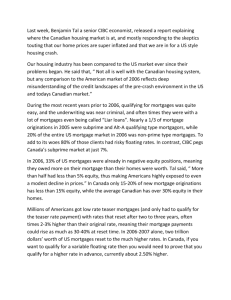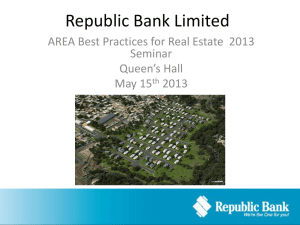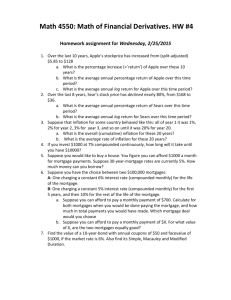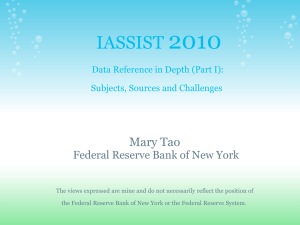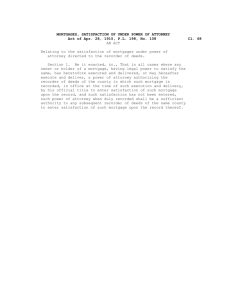Lecture16
advertisement
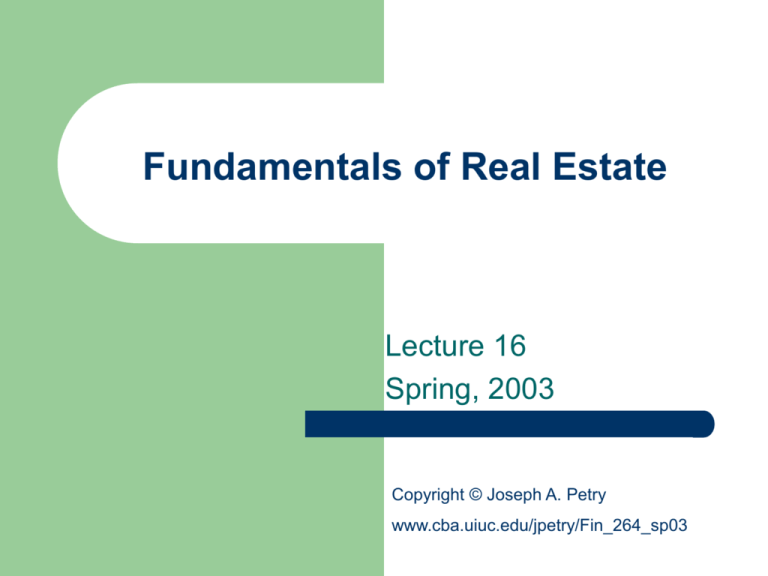
Fundamentals of Real Estate Lecture 16 Spring, 2003 Copyright © Joseph A. Petry www.cba.uiuc.edu/jpetry/Fin_264_sp03 Chapter 14: Creation of Mortgages Mortgages The mortgage creates an interest in a property to secure payment of a debt or obligation. 2 Mortgages are legal documents which give lenders contingent claims against real estate. The borrower, who gives the mortgage, is the mortgagor The lender, who receives the pledge, is the mortgagee Borrowers are obligated by the promissory note (bond) to repay the mortgage loan. Chapter 14: Creation of Mortgages Mortgages In the event of borrower default, lenders may exercise their claim against the property through foreclosure. In title-theory states, lenders technically receive title to property in mortgage contracts. The lender can only exercise his/her property rights if the borrower defaults. – 3 Mortgage contracts carry “power-of-sale” clauses in these states which allows expeditious foreclosure In lien-theory states lenders get security interest (rather than title) that grants them the right to force the sale in the event of default. In some states, third party trustees receive title (Deeds-oftrust). In case of default, lender asks trustee to take action to force the foreclosure. Chapter 14: Creation of Mortgages Mortgages The mortgage market consists of two components: 1. 2. Primary market Secondary market The primary mortgage market The mortgage contract is originated between the lender and the borrower. Money flows to the lender from: 4 deposits (banking institutions), insurance policy premiums (insurance companies) pension contributions (pension funds), the secondary market. Chapter 14: Creation of Mortgages Mortgages The secondary mortgage market Firms known as conduits may assist with the sale of the lender’s mortgage Mortgages can be transformed from a pool of mortgages into a mortgage-backed security and sold to multiple investors. 5 Chapter 14: Creation of Mortgages Capital Flows to Mortgages The Four Quadrants of Real Estate Finance Private Public Equity Individuals Equity REITs Pension Funds Real Estate Corporations Mortgage Debt Banks Mortage-Backed Securities Insurance Companies 6 Chapter 14: Creation of Mortgages Capital Flows to Mortgages Studies indicate that the residential mortgage market and the capital markets are well integrated Mortgage rates and Treasury bond rates have followed a nearly identical pattern since the late 1980s • 7 Mortgage rates are about 100bps higher than the 10 year treasury Chapter 14: Creation of Mortgages Clauses Found in Mortgage Contracts Requirements of Valid and Enforceable Mortgages: • Must include essential elements of a standard contract, • Must be in writing, and properly describe the property • And must include the following: 8 • • • • • Identify the property rights being pledged Include the words of conveyance, Include the signature of the mortgagor Be delivered to the mortgagee and recorded Contain reference to the note, or obligation Chapter 14: Creation of Mortgages Common Mortgage Clauses: • Acceleration clause, • Prepayment (and lock-out provisions) and late payment penalties clause • Due-on-sale clause, • Santa clause • Property tax and hazard insurance clause • Interest escalation and adjustment clause Non-uniform clauses may be included for the lender to comply with respective laws. 9 Chapter 14: Creation of Mortgages Residential Mortgage Documents: Typical clauses in the standard residential note include: • Date the note is executed • Name of the mortgagor and mortgagee • Acceleration clause • Terms of the debt (e.g. interest rate, type of amortization, frequency of payments, maturity date) • Prepayment penalties • Escalation clause on delinquent penalties 10 Chapter 14: Creation of Mortgages Typical standard residential mortgage form extends somewhat longer than the note. The clauses in the mortgage fall into either: 1. Uniform clauses: • Require actions on the part of the borrower • Keep the property in good condition • Give notice to lender if additional liens are placed on the property 2. Non-uniform clauses are required by particular states (e.g.): • • 11 Specific acceleration remedies may be available to lenders in the event of borrower default The assignment of rents to lenders in the event of default Chapter 14: Creation of Mortgages The standard trust deed for residential property differs from the the mortgage in that: • • • • Three parties, instead of two, are named Lenders are given nonpossessionary security interests, while trustees are given possessionary security interests Trustees are given the power of sale Provisions are made for an alternative trustee Mortgage Borrower and Lender Relationships 12 Extensions of the simple mortgage contract • First mortgage is most common and gives lender highest priority among lenders. Extensions include: Chapter 14: Creation of Mortgages • • • Junior mortgage represents an additional pledge of the property to another loan. In event of default, the claims of the mortgagee on the junior mortgage are second to the first mortgage. Wrap-around mortgage involves additional financing, usually from the seller of the property, in which a new loan is created around an existing loan that the seller keeps in place. Assumption of an existing mortgage occurs when the buyer takes over the payments of the original loan. • 13 Subject to mortgage: If the buyer takes title to property subject to existing mortgage, the buyer does not take on personal liability—original borrower remains liable. The mortgage is drafted so that the buyer’s property is used to secure the loan. Chapter 14: Creation of Mortgages • • • Assumption of the mortgage: If the buyer takes title to the property by assuming the existing mortgage (both the mortgage and the note change) and only the buyer is liable in case of default, provided the seller’s liability is relieved by the lender. Purchase money mortgage occurs when the owner takes the role of both the seller of the property and the first mortgage lender Land contract occurs when seller financing is provided and the title to the property changes hands when some percentage (e.g. 50%) of the loan is repaid. Single-family residential mortgages • 14 For existing properties, permanent mortgages for singlefamily homes fall into three categories: Chapter 14: Creation of Mortgages 1. Conventional 2. Government-supported mortgages (e.g. FHA, VA) 3. Owner (seller) financing Construction financing finances the development of the site and construction of the improvements during construction • A forward commitment (or takeout) occurs when a lender agrees to provide a long-term loan upon the completion of construction and often the fulfillment of other conditions. • Construction loans granted once forward commitments are in place are termed covered loans • Construction loans granted without forward commitments are termed uncovered, or open-end loans. 15 Chapter 14: Creation of Mortgages Income Property Mortgages • Partial amortization, income and equity participation, and various prepayment penalty clauses are often features of loans written on existing income properties. • Forward commitments on income-properties may contain specific performance targets such as completion date and percent of space occupied. 16 Chapter 14: Creation of Mortgages Adjustments to Borrower and Lender Relationships • • Satisfactory payment in full Default and foreclosure 1. Delinquency and default Delinquency occurs when the borrower fails to make timely payments as specified in the mortgage contract Mortgage default usually results from nonpayment or lack of timely payment (prolonged delinquency). Technical default can occur as a result of non-payment of property taxes and insurance premiums, or if the borrower fails to adequately maintain the property. 2. Equity of redemption The legal right of delinquent borrowers to pay the outstanding balance, interest and court costs to redeem the equity in their property. Equity right of redemption occurs before foreclosure. 17 Chapter 14: Creation of Mortgages 3. Judicial and nonjudicial foreclosure Judicial foreclosure means selling the property through a court procedure to satisfy a lien (generally followed in lien-theory states). Nonjudicial foreclosure rules, with respect to notification and sale procedures, are generally followed in title-theory states. 4. Statutory period of redemption A period of time enacted in some states in which the borrower can redeem the property after foreclosure by paying the outstanding debt, interest and legal fees. • • • 18 Assumption of Mortgages Recasting a Mortgage Sale of the Mortgage


